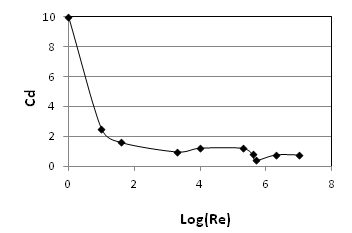For a cylindrical tube in steady flow, the drag coefficient
may vary with flow velocity, tube diameter, surface roughness. For
a smooth cylinder, the drag coefficient can be expressed as a function
of Reynolds number . In this definition,
is the kinematic viscosity at sea water
at 40 °C and
is the steady flow velocity. This function is known
as the Wieselburger curve, as shown in Figure 6.2: Drag Coefficients Versus Reynolds Numbers for Circular Cylinder. Barltrop and Adams [5] described that for small Reynolds numbers,
the drag is mainly due to skin friction as a function of magnitude
of flow velocity, hence the drag coefficient is relatively large.
For larger Reynolds numbers, the drag force is mainly from low pressure
in the wake as a function of velocity squared. The corrections with
surface roughness and Keulegan-Carpenter number can be found in the
literature (for example, [5]), in which
Keulegan-Carpenter number is defined as
where
is wave particle orbit size.
Aqwa normally assumes that the Reynolds Number is sufficiently large for the drag coefficient to be considered constant. The Morison element drag coefficients defined either directly by the user or automatically by Aqwa will be used.
However if this is not a reasonable assumption, a model test factor can be defined to calculate the local Reynolds number. Even though experimental evidence shows that the Reynolds number is not a simple function of the velocity and diameter for cylinders with arbitrary orientation to the direction of the fluid flow, considerable improvement in agreement with model tests has been obtained by using the scale factor to obtain a local Reynolds number and interpolating from classic experimental results.
The scale factor number is
(6–3) |
where is the characteristic length of the prototype structure,
is its testing model length.
If Reynolds number of a prototype tube is , the local Reynolds number for the corresponding
experimental model should be
(6–4) |
where is the velocity transverse to the axis of the prototype
tube with diameter of
.
Using this local Reynolds number and employing the Wieselburger curve given by Figure 6.2: Drag Coefficients Versus Reynolds Numbers for Circular Cylinder, the actual drag coefficient for the model test case can be interpolated. In such special case, the drag coefficients for all Morison tube elements on all structures previously defined by user are ignored.



